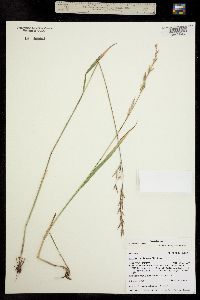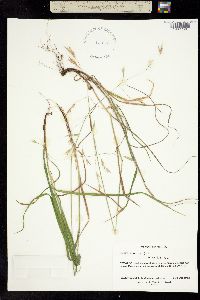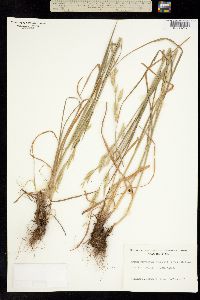Bromus carinatus
|
|
|
|
Family: Poaceae
Arizona brome, more...California Brome, mountain brome (es: bromo de california)
[Bromus carinatus var. californicus (Nutt. ex Buckl.) Shear, moreBromus carinatus var. densus Shear, Bromus carinatus var. hookerianus (Thurb.) Shear, Bromus compressus Lag., Bromus hookeri var. pendulinus (Spreng.) E. Fourn., Bromus hookeri var. schaffneri E. Fourn., Bromus hookeri var. schlechtendalii E. Fourn., Bromus hookerianus var. minor Scribn. ex Vasey, Bromus japonicus var. anatolicus (Boiss. & Heldr.) Asch. & Graebn., Bromus laciniatus Beal, Bromus nitens Nutt. ex A. Gray, Bromus oregonus Nutt. ex Hook. f., Bromus pendulinus Sessé ex Lag., Bromus proximus var. sclechtendalii (E. Fourn.) Shear, Bromus schaffneri (E. Fourn.) Scribn. & Merr., Bromus sitchensis var. carinatus (Hook. & Arn.) R.E.Brainerd & Otting, Bromus virens Buckley, Bromus virens var. minor Scribn. ex Beal, Ceratochloa carinata (Hook. & Arn.) Tutin, Ceratochloa grandiflora Hook., Festuca pendulina Spreng.] |
Dr. David Bogler, USDA NRCS PLANTS Database Perennials, Terrestrial, not aquatic, Stems nodes swollen or brittle, Stems erect or ascending, Stems caespitose, tufted, or clustered, Stems terete, round in cross section, or polygonal, Stem internodes hollow, Stems with inflorescence less than 1 m tall, Stems, culms, or scapes exceeding basal leaves, Leaves mostly cauline, Leaves conspicuously 2-ranked, distichous, Leaves sheathing at base, Leaf sheath mostly closed, Leaf sheath hairy, hispid or prickly, Leaf sheath hairy at summit, throat, or collar, Leaf sheath and blade differentiated, Leaf blades linear, Leaf blade auriculate, Leaf blades 2-10 mm wide, Leaf blades 1-2 cm wide, Leaf blades mostly flat, Leaf blades mostly glabrous, Leaf blades more or less hairy, Ligule present, Ligule an unfringed eciliate membrane, Inflorescence terminal, Inflorescence an open panicle, openly paniculate, branches spreading, Inflorescence solitary, with 1 spike, fascicle, glomerule, head, or cluster per stem or culm, Inflorescence with 2-10 branches, Inflorescence branches more than 10 to numerous, Flowers bisexual, Spikelets pedicellate, Spikelets laterally compressed, Spikelet 3-10 mm wide, Spikelets with 3-7 florets, Spikelets with 8-40 florets, Spikelets solitary at rachis nodes, Spikelets all alike and fertille, Spikelets bisexual, Spikelets disarticulating above the glumes, glumes persistent, Spikelets disarticulating beneath or between the florets, Rachilla or pedicel glabrous, Glumes present, empty bracts, Glumes 2 clearly present, Glumes distinctly unequal, Glumes shorter than adjacent lemma, Glumes keeled or winged, Glumes 3 nerved, Glumes 4-7 nerved, Lemmas thin, chartaceous, hyaline, cartilaginous, or membranous, Lemma 5-7 nerved, Lemma glabrous, Lemma body or surface hairy, Lemma apex dentate, 2-fid, Lemma distinctly awned, more than 2-3 mm, Lemma with 1 awn, Lemma awn less than 1 cm long, Lemma awn 1-2 cm long, Lemma awn subapical or dorsal, Lemma awns straight or curved to base, Lemma awn twice geniculate, bent twice, Lemma margins thin, lying flat, Lemma straight, Palea present, well developed, Palea membranous, hyaline, Palea shorter than lemma, Palea 2 nerved or 2 keeled, Palea keels winged, scabrous, or ciliate, Stamens 3, Styles 2-fid, deeply 2-branched, Stigmas 2, Fruit - caryopsis, Caryopsis ellipsoid, longitudinally grooved, hilum long-linear, Caryopsis hairy at apex.
FNA 2007, Gould 1980 Common Name: Arizona brome Duration: Annual Nativity: Native Lifeform: Graminoid General: Tufted annual to perennial grass with stems 40-80 cm tall. Vegetative: Sheaths closed to within a few centimeters of the ligule, throats usually hairy; ligule membranous, glabrous or sparsely hairy, acute or obtuse, lacerate, 2-4 mm long; blades flat, glabrous or sparsely pilose, mostly 4-8 mm broad, 1-30 cm long. Inflorescence: Panicle generally 12-30 cm long, lax, lower branches 1-4 per node, each shorter than 10 cm, ascending to strongly divergent or reflexed, with 1-4 spikelets per branch; spikelets with 6-11 florets; glumes large but shorter than lowermost lemma, glabrous to pubescent, unequal to nearly equal in length, first glume three-nerved, second broader and five to seven nerved; lemmas 12-16 mm, strongly keeled distally, usually more or less uniformly pubescent, sometimes scabrous, 7-veined; awns 8-17 mm, sometimes slightly geniculate; caryopsis as thick or thicker than broad. Ecology: Found in forests, shrublands, grasslands, meadows, and openings in chaparral and oak and yellow pine woodlands; often in moist soil and partial shade, below 9,000 ft (2743 m); flowers July-November. Distribution: Widespread across western North America and south into Mexico. Notes: Closely related to B. catharticus, B. arizonicus, and B. marginatus. All four of these species belong to a section Ceratochloa in the Bromus genus, with spikelets that are strongly flattened and lemmas that are strongly keeled, forming a V shape in median cross section. B. catharticus is distinguished from the other 3 species by being awnless to nearly awnless, with awns <4mm. Differences between B. arizonicus, B. carinatus, and B. marginatus are more subtle and difficult to see without a hand lens or microscope. In some treatments, these taxa are considered to be three varieties of the same species (B. carinatus). B. carinatus has a wide range and can be an annual or biennial, while B. arizonicus is a low elevation (<5,000 ft) annual and B. marginatus is a higher elevation perennial. B. carinatus is distinguished from B. arizonicus by its shorter glumes, which are are not as long as the first lemma, and the lack of prominent veins on the back of the lemma. B. carinatus is distinguished from B. marginatus by its longer awns (8-17 mm vs. B. marginatus at 4-7 mm). Ethnobotany: Seeds parched, ground into flour, used also for mush. Etymology: Bromus is from Greek bromo, for stinking, while carinatus means keeled like a boat. Synonyms: Bromus carinatus var. californicus, B. carinatus var. hookerianus, B. laciniatus, Ceratochloa carinata Editor: SBuckley 2010, AHazelton 2015 Coarse, tufted, rather short-lived perennial 3-12 dm, often fl the first season, glabrous or hairy; blades flat and broad, 3-9 mm wide; ligule 1-3(-4) mm; panicles 10-20+ cm, loosely contracted, often nodding; spikelets 20-30(-40) mm, 5-10-fld, strongly compressed; glumes lanceolate, acute, strongly keeled, the first 7-11 mm, 3- or 5-veined, the second 9-13 mm, 5- or 7-veined; lemmas 11-15(-17) mm, keeled, ca 7-veined, soon spreading and exposing the elongate (2.5-5 mm) joints of the rachilla; awns (3-)4-(-8) mm; palea nearly as long as the lemma; 2n=28, 42, 56, 70. Moist open places; native to the w. cordillera, and casually intr. e. to Io. and Ill. (B. marginatus) Gleason, Henry A. & Cronquist, Arthur J. 1991. Manual of vascular plants of northeastern United States and adjacent Canada. lxxv + 910 pp. ©The New York Botanical Garden. All rights reserved. Used by permission. |
|
|
|


































































































